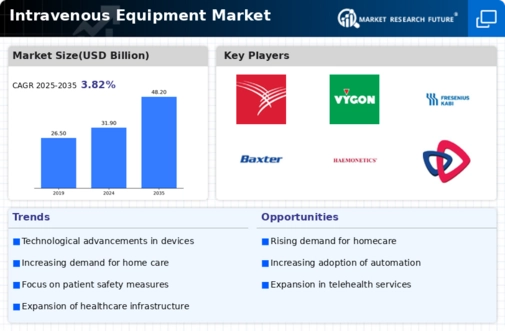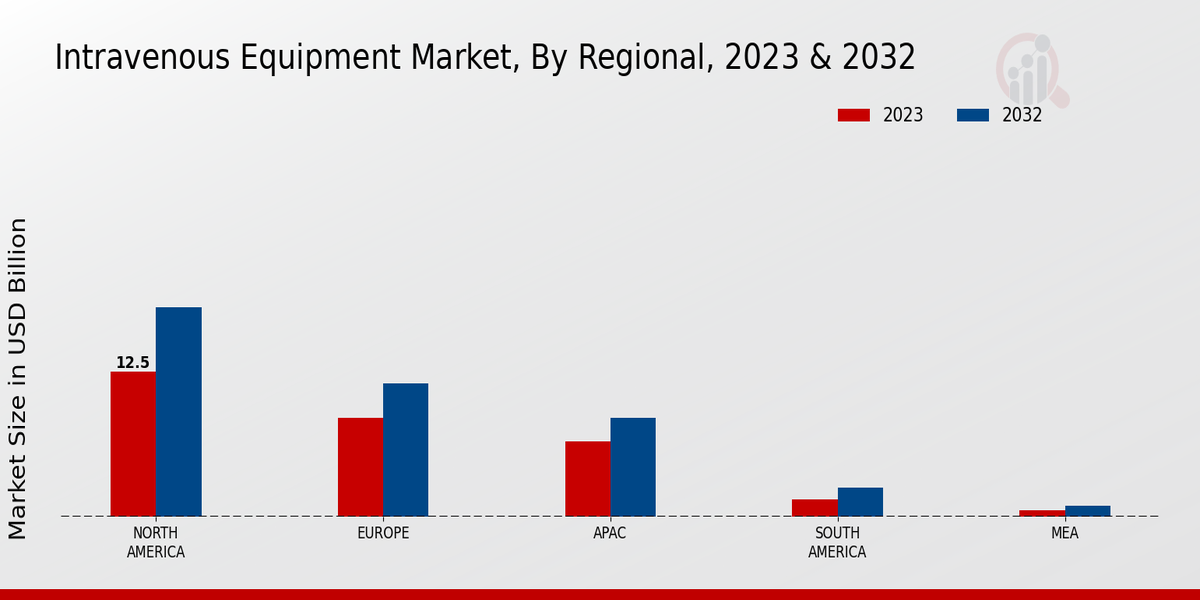Market Growth Projections
The Global Intravenous Equipment Market Industry is poised for substantial growth, with projections indicating a market value of 31.9 USD Billion in 2024 and an anticipated increase to 48.2 USD Billion by 2035. This growth trajectory suggests a robust demand for intravenous solutions, driven by various factors including technological advancements, increased healthcare investments, and a focus on patient safety. The market is expected to experience a compound annual growth rate (CAGR) of 3.82% from 2025 to 2035, reflecting the ongoing evolution of healthcare practices and the critical role of intravenous therapies in patient management. These projections underscore the industry's potential for expansion and innovation.
Growing Awareness of Patient Safety
The emphasis on patient safety significantly influences the Global Intravenous Equipment Market Industry. Healthcare providers are increasingly prioritizing safety protocols to minimize risks associated with intravenous therapies. This awareness leads to the adoption of safer IV equipment, such as needleless systems and antimicrobial catheters, which reduce the likelihood of infections and complications. As patient safety becomes a central focus in healthcare, the demand for advanced intravenous solutions is expected to rise. This trend aligns with the broader movement towards quality improvement in healthcare, further driving the market's growth. The commitment to patient safety is likely to shape purchasing decisions and influence market dynamics.
Rising Demand for Healthcare Services
The Global Intravenous Equipment Market Industry experiences a notable surge in demand for healthcare services, driven by an aging population and increasing prevalence of chronic diseases. As the global population ages, the need for effective treatment options, including intravenous therapies, escalates. In 2024, the market is projected to reach 31.9 USD Billion, reflecting the growing reliance on intravenous equipment in hospitals and outpatient settings. This trend is likely to continue, as healthcare providers seek advanced solutions to enhance patient care and treatment efficiency. The increasing number of surgical procedures further contributes to this demand, indicating a robust growth trajectory for the industry.
Technological Advancements in IV Equipment
Technological innovations play a pivotal role in shaping the Global Intravenous Equipment Market Industry. The introduction of smart infusion pumps and advanced catheter systems enhances the safety and efficacy of intravenous therapies. These innovations reduce medication errors and improve patient outcomes, which is crucial in modern healthcare settings. As hospitals adopt these technologies, the market is expected to grow significantly, with a projected value of 48.2 USD Billion by 2035. The integration of digital health solutions and telemedicine further supports this growth, as healthcare providers increasingly rely on sophisticated equipment to deliver high-quality care. This trend underscores the importance of continuous innovation in the industry.
Regulatory Support for IV Equipment Standards
Regulatory bodies play a crucial role in the Global Intravenous Equipment Market Industry by establishing standards that ensure the safety and efficacy of intravenous products. Stringent regulations and guidelines promote the development of high-quality equipment, fostering consumer confidence in intravenous therapies. As regulatory frameworks evolve, manufacturers are compelled to innovate and comply with these standards, which can enhance market competitiveness. This regulatory support is essential for maintaining product quality and safety, ultimately benefiting patients and healthcare providers alike. The ongoing collaboration between regulatory agencies and industry stakeholders is likely to drive advancements in intravenous equipment, contributing to the market's sustained growth.
Increasing Investment in Healthcare Infrastructure
Investment in healthcare infrastructure is a critical driver for the Global Intravenous Equipment Market Industry. Governments and private entities are allocating substantial resources to enhance healthcare facilities, particularly in developing regions. This investment leads to the establishment of new hospitals and clinics, which in turn increases the demand for intravenous equipment. As healthcare systems expand, the need for reliable and efficient IV solutions becomes paramount. The market's growth is projected to follow a CAGR of 3.82% from 2025 to 2035, reflecting the long-term commitment to improving healthcare access and quality. Enhanced infrastructure not only supports existing healthcare needs but also prepares for future challenges.










